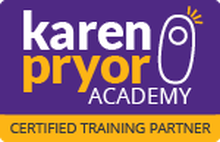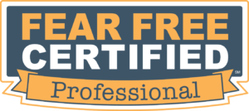|
Dogs need to wear muzzles for various reasons. Maybe they pick up food off the ground outside, maybe they don't like to be handled at the vet, maybe they can be aggressive towards people or other dogs in various situations, and sometimes owners just want to give their dog some extra space from others, and muzzles can help with that. Muzzles unfortunately have a negative stigma with a lot of people, but the truth is that they're important tools that can help keep your dog and everyone else safe. This is the part where I remind you that if your dog is displaying worrisome behavior including aggression or fearfulness, I recommend that you seek the services of a professional behavior consultant, who will be able to support you through your dog's training which may include teaching them to wear a muzzle! Now a muzzle is one of those tools that most dogs won't tolerate very well if you just put it on them. I'm going to outline one method that I use to desensitize a dog to wearing a muzzle, while building a strong positive response to the tool. We'll follow the journey of Uno, the Shiba Inu mix. All these videos are from my actual day training sessions with Uno and he's learning each step for the first time as you view it in the video. These are edited down from 5-6 minute videos in some cases, but generally I tried to show the beginning of each session so you can see how he responds to each increase in criteria. You'll notice a lot of repetition, and very small changes in criteria built on previous successes. Uno is using a Baskerville Ultra muzzle, which is my favorite for working with my clients. It's a basket muzzle, so he can open his mouth and breathe safely, and the spacing is such that I can feed him through the bars of the muzzle. You can find them on Amazon, and they have a sizing guideline. Jafco also makes a lovely muzzle, and you can get it with a treat hole. My favorite custom, light weight muzzles are made by Bumas. The first step is to simply have your dog comfortable putting their nose in the muzzle, which I do by using it as a sort of bowl by cupping the bottom with my hand, while putting treats inside for Uno to eat. This is only if your dog doesn't have a previous negative experience with muzzles, or isn't inherently afraid of novel objects. If your dog is uncomfortable just seeing the muzzle at any distance, you need to do some foundation work before you can get to this part. The next step, only once Uno is very comfortable with putting his nose in the muzzle, is to start feeding those treats from the outside of the muzzle. Different dogs will proceed at different speeds. Uno got this part pretty quickly, but if it takes your dog several sessions to move from the first step to the second step, that's OK! The most important component of this training is that we move at your dog's speed. If you push too quickly and make things more difficult than your dog is ready for, you run the risk of your dog making negative associations and taking your training back several steps while you work through your dog's concerns. At this point I've switched to a squeeze bottle filled with a mixture of whipped cream cheese and liverwurst, as I find them easier to use in this context, but you can use regular treats in much the same way. I'm still focused on making the association for Uno that super yummy things come from the muzzle when his nose is inside it. Now we're working towards tiny little pauses between treats while he's wearing the muzzle with him keeping his face in the muzzle during the pauses. This is the foundation for the rest of our muzzle work - slowly increasing the duration of those pauses. When he does pull his face out, the bottle goes away, but he's not forced to put his face back in. He does on his own (because he's had a long and strong reinforcement history of it at this point) and the treating continues. It's super important that your dog can always pull his face out at this point, and that there's no negative consequence for doing so. Here you can see the pauses between the streams of food getting longer, and I also tossed him treats away to reset him so he can practice targeting the muzzle with his face, which starts the food stream again. Now we start to put the strap over his ears, very loosely. You can also see that I'm feeding him with fewer pauses - when you make one component more difficult (adding the strap), it's important to make other components less difficult (how long he has to wait between treats). Some more practice with just putting the strap on, this time with treats at the front of the muzzle instead of the bottle - it's a bit easier to handle this way! Now that Uno's had some experience feeling the full weight of the muzzle on his face without support from me, we're working on increasing the pauses between treats again. Uno has graduated to significantly longer pauses between treats, so we're going to try moving around with the muzzle on! This is a big step, and one at which many dogs will start to paw at the muzzle. It's important to take your time getting here and treat your dog frequently enough that they don't worry too much about the muzzle. If Uno were to start pawing at it, I would call him to get his attention and get him back on the bottle. If he had a hard time with that, I would take a step back and ask him to move around less, and increase how often I give him treats. After Uno's comfortable moving around with the muzzle on, we progress to asking him to do other behaviors he already knows, in this case it's a hand target. I would not recommend trying to teach him something new at this point, stick with behavior your dog likes to do already. Once Uno was comfortable moving around his apartment and doing various behaviors with his muzzle on, we were able to pretty seamlessly get him wearing it outside on his walks. In this video you can see him walking nicely with his mom, wearing his muzzle like a pro.
6 Comments
|

 RSS Feed
RSS Feed

